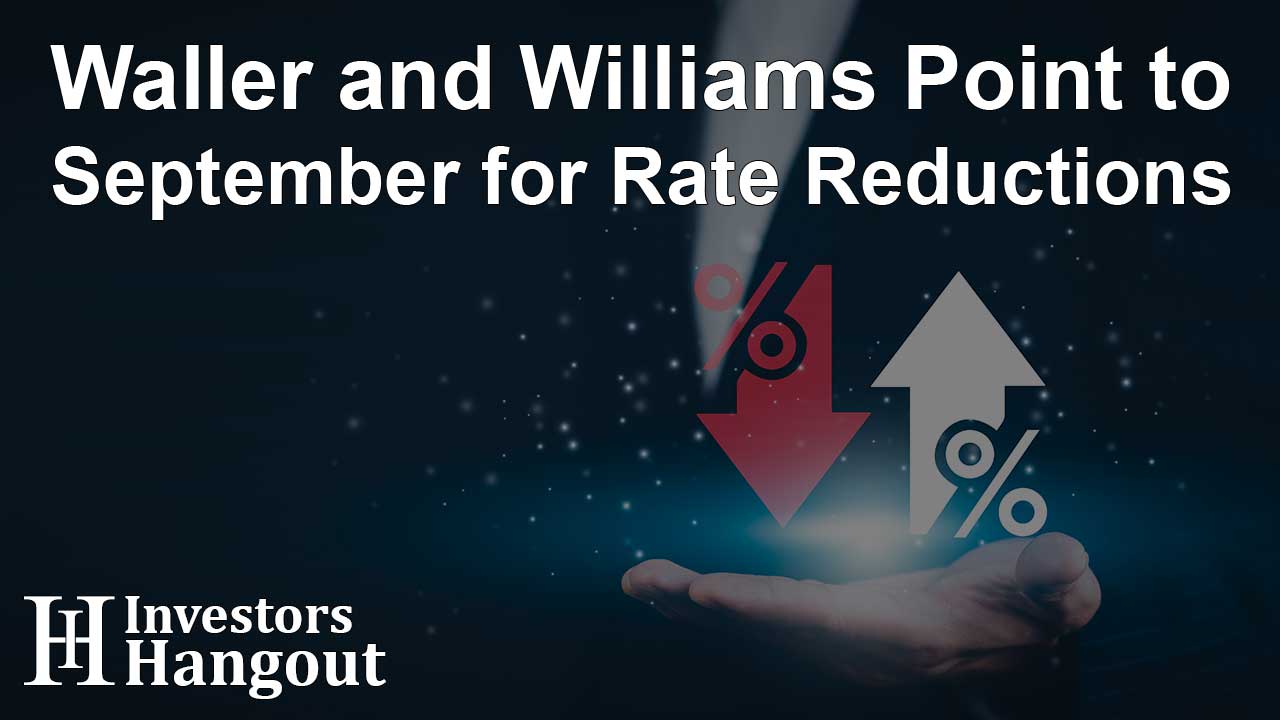Waller and Williams Point to September for Rate Reductions

Fed Officials Signal Closer Move to Interest Rate Cuts
Top Federal Reserve officials say the U.S. central bank is almost decided on lowering interest rates. Better inflation patterns and a more balanced labor market help to support this change. Recent comments by Fed Governor Christopher Waller and New York Fed President John Williams both underlined this. Their implication of a possible September rate cut shows faith in the present course of the economy. Thomas Barkin, President of Richmond Fed, also observed generally declining inflation, which he finds hopeful. These remarks line up with remarks made by Fed Chair Jerome Powell lately. The comments of these officials taken together show growing hope for reaching the Fed's inflation targets.
The remarks of the Fed fall among a string of public remarks by senior officials. They underline the growing conviction that the disinflationary trend observed since last year is extending. Though there have always been fluctuations, price pressures seem to be relieving in many different industries. Housing costs are stabilizing, goods prices are declining, and wage increase is slowing down. Reducing the inflation in the services sector depends on this multifarious easing. The remarks of the officials highlight their belief that rate reduction time is almost here. They also represent a more general Fed agreement on the present state of the economy.
Waller and Williams Highlight September as Key Timeframe
For possible interest rate cuts, Fed Governor Waller and New York Fed President Williams are citing September. Emphasizing this period, Waller in his speech at the Kansas City Fed omitted July from discussion. In a Wall Street Journal interview, Williams reflected this point of view by stressing the significance of forthcoming inflation figures Both officials emphasize the need of looking at economic situation over next few months. This phase will offer important new perspectives on the sustainability of the disinflationary trend. Their emphasis on September points to a wary yet hopeful attitude. Before deciding on rate reduction, they are awaiting more data.
With hopes of rate reductions later in the year, financial markets mirror this measured optimism. Now less than 5% of market players are confident about a Fed rate cut in July. Still, they expect cuts ranging from September through December. By the end of 2024, these possible cuts could bring the benchmark policy rate down into the 4.50%-4.75% range. This point of view fits Waller and Williams' wary but hopeful one. They underline data-driven decisions and wait for consistent indicators of inflation's lowering. Their comments point to a methodical approach to change in monetary policy.
Richmond Fed President Encouraged by Broad Inflation Decline
Thomas Barkin, President of Richmond Fed, voiced hope on the general declining inflation trend. Speaking to a Maryland corporate group, he underlined the importance of current developments. The spread of these declines across several sectors excites Barkin. He underlines the need of this trend's continuation for ongoing economic stability. Barkin's remarks fit the general opinion among Fed officials. They show a developing faith that inflation is headed in the correct direction. His comments support the case for possible near future rate reductions.
Barkin's enthusiasm fits a greater story inside the Federal Reserve. Top officials have growing faith that inflation is headed down. This confidence results from notable changes in services, housing, and consumer products prices. Barkin's focus on the wide scope of these declines draws attention to a thorough economic recovery. His opinions help to support the theory that the Fed might soon change to a more relaxed monetary policy. This change seeks to augment the continuous disinflationary trend. Barkin's observations add to the general story of cautious optimism inside the Fed.
Disinflationary Trends Continue Despite Earlier Bumps
Fed officials observe that the disinflationary trend has persisted in spite of past fluctuations. Beginning last year, this trend has shown fortitude through current economic difficulties. Top officials, including Fed Chair Jerome Powell, have emphasized this ongoing development. They admit that earlier this year inflation momentarily surged but soon started its downward slide. This consistent drop in inflation helps the Fed to be confident about possible rate reductions. Additionally mentioned by Fed Governor Adriana Kugler were contributions from the housing, goods, and service industries. Sustained disinflation depends on this multi-sector progress.
The consistent disinflationary trend implies that earlier shocks were transient. Officials of the Fed are increasingly certain about the state of the economy. Recent data showing declining inflation rates helps one to get confidence. The comments of Fed Chair Powell underline this better direction. From its epidemic peak, the Fed's preferred inflation estimate dropped significantly. Long term objectives of the Fed depend on this continuous trend. The comments of the officials show a great conviction that the economy is headed in the right direction.
Easing Price Pressures in Goods, Housing, and Services
Top Fed officials report that price pressures are relieving generally. Housing costs are rising slowly, goods prices are declining, and wage rise is slowing down. These developments help to bring about the much-needed relief from rising service sector prices. Fed officials stressing these trends included Christopher Waller and John Williams. Achieving the Fed's inflation targets depends on these developments, thus they are absolutely important. This multifarious easing points to a more controllable inflation. It lays a strong basis for possible later this year rate reductions.
Positive indicators for the state of the economy are the relaxation of price pressures in different sectors. It suggests that starting to show effects are Fed policies. To guarantee their continuation, officials are attentively tracking these patterns. The prices of goods, homes, and services have lately shown encouraging changes. They propose that the Fed's 2% target is being approached by inflation. Maintaining economic stability depends on this advance. Fed officials hope these trends will continue, which will let monetary policy maybe change.
September Rate Cut Potentially in Play, July Cut Unlikely
Officials of the Federal Reserve suggest that September's rate reduction is more likely than that of July. John Williams and Christopher Waller both have decided against a rate cut for the next July conference. Before deciding, they underline the need of more data. Given a low likelihood of a July rate cut, financial markets also mirror this attitude. But they see possible cuts beginning in September. This wary approach emphasizes the Fed's data-driven policy. Before acting, officials are waiting for consistent indicators of inflation's lowering.
Recent economic data points support a possible September rate reduction. The labor market and inflation show encouraging patterns according to Fed officials. These patterns point to stabilization of the economy. The September emphasis of the officials gives time to evaluate more data. This time will offer important new perspectives on whether the present trends are sustainable. The cautious optimism betrays a deliberate Fed balancing act. They want to boost the economy without running unneeded hazards.
Mixed Scenarios for Inflation Outlook by Fed Officials
Fed Governor Christopher Waller presented three scenarios for the future inflation rate. Based on his observations, the first two scenarios—which he regards as most likely—suggest ongoing inflation moderation. One situation is more gradual; the other involves a fast and constant drop. The third, least likely possibility is inflation picking up speed once more. Waller's study captures the Fed's reserved hope. The first two situations seem most likely, in his opinion. This view supports the argument for possible later this year rate reductions.
Waller's scenarios show the uncertainty in the inflation projection. The Fed keeps alert even with recent gains. They are ready to change their policies as necessary and ready for many possible results. Waller's comments highlight the need of basing decisions on facts. To direct their activities, the Fed is attentively examining economic indicators. This method guarantees their ability to adapt to changing surroundings. Waller's study gives the Fed's cautious yet hopeful viewpoint more complexity.
Progress in Inflation Reduction Raises Fed's Confidence
The Fed's confidence has grown as recent inflation lowering efforts show promise. Notable improvements have been observed by top officials including Fed Chair Jerome Powell. Declining prices for goods, housing, and services clearly show this advancement. Adriana Kugler, Fed Governor, highlighted the efforts in these areas. Maintaining continuous economic stability depends on this multifarious development. The comments of the officials show an increasing conviction that inflation is approaching the 2% target of the Fed. This assurance helps to support future rate reductions' possibility.
Recent data demonstrating consistent inflation declines helps the Fed maintain its confidence. From its pandemic peak, the preferred inflation indicator clearly dropped. Long-term goals of the Fed depend on this continuous improvement. The comments of the officials expose a wary hope about the state of the economy. They are awaiting more information to validate the longevity of these developments. Rate cuts' possibility rests on ongoing development. The Fed is still mostly concerned with reaching its inflation targets and fostering economic expansion.
About The Author
Contact Addison Perry privately here. Or send an email with ATTN: Addison Perry as the subject to contact@investorshangout.com.
About Investors Hangout
Investors Hangout is a leading online stock forum for financial discussion and learning, offering a wide range of free tools and resources. It draws in traders of all levels, who exchange market knowledge, investigate trading tactics, and keep an eye on industry developments in real time. Featuring financial articles, stock message boards, quotes, charts, company profiles, and live news updates. Through cooperative learning and a wealth of informational resources, it helps users from novices creating their first portfolios to experts honing their techniques. Join Investors Hangout today: https://investorshangout.com/
